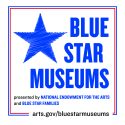Iowa born Grant Wood (1892-1941) is one of the major artists in American history and Midwest history. Wood set out to portray the essential identity of the rural Midwest.
As art historian John Wilmerding has noted, Wood developed his own style after studying in Europe the German, Flemish, and French primitives of the Northern Renaissance. Wood perfected sharp details, meticulous clarity, severe poses, and hard staring eyes. Wood became famous for his precise observations of everyday life in rural America.

Cedarhurst exhibits Wood’s Self-portrait, 1917, Brass, [inset: 3×2”, art displayed in shadow box], Gift from the Estate of Virginia L. Rohrbacher, Cedarhurst permanent collection 2003.02

Renowned today for American Gothic, 1930, oil, 29×25”, Art Institute of Chicago, for which Wood’s sister and his dentist modeled. Image courtesy of Wikipedia
Here, again, we see the major theme of the Cedarhurst collection of “everyday life” that runs through the entire historic sweep of American art and often clashes with the modernist current that flows alongside.
Wood along with Thomas Hart Benton (Missouri) and John Steuart Curry (Kansas) established Regionalism as a dominant style of American art in the 1930s.

John Steuart Curry, Tragic Prelude, c.1940, oil, egg tempera, 11’4” x 31 feet, Kansas State Capitol, Topeka, KS. Image courtesy of Wikipedia

The mural scale viewed by Kansas Governor Sam Brownback (left) with U.S. Secretary of Education Arne Duncan in 2012. Image courtesy of Wikipedia
Art historian Ericka Doss wrote, “While seemingly focused on specific Midwestern places, Regionalism embodied the larger cultural project of blending America’s multiple “locals” into a national picture of unity.”
Regionalism, also known as American Scene Painting, was storytelling art in a decidedly optimistic mood. Hard work, self-reliance, and community were the social values immortalized in the art of Wood, Curry, and Benton.
“Regionalism’s brand of modern American art became a means of regaining the self-esteem and social respectability undercut by the Great Depression.” Art historian Erika Doss.

Thomas Hart Benton, The Sources of Country Music, 1975, acrylic, 72×120”, The Country Music Hall of Fame and Museum, Nashville, Tennessee. Image courtesy of Wikiart
Regionalism as Wood, Benton, and Curry painted it, portrayed local community values as the standard for a cultural nationalism, striving to have the Midwestern ethos regarded as the essence of American national identity.
The early twentieth-century art themes of Robert Henri and the Ashcan artists that foregrounded everyday American life continued in the 1930s art of Grant Wood, John Steuart Curry, and Thomas Hart Benton and flowing right into the postmodern Midwest of famed comic artist Chris Ware.
Visit the permanent collection gallery at Cedarhurst to see firsthand the art of Robert Henri, Grant Wood, and Chris Ware.





